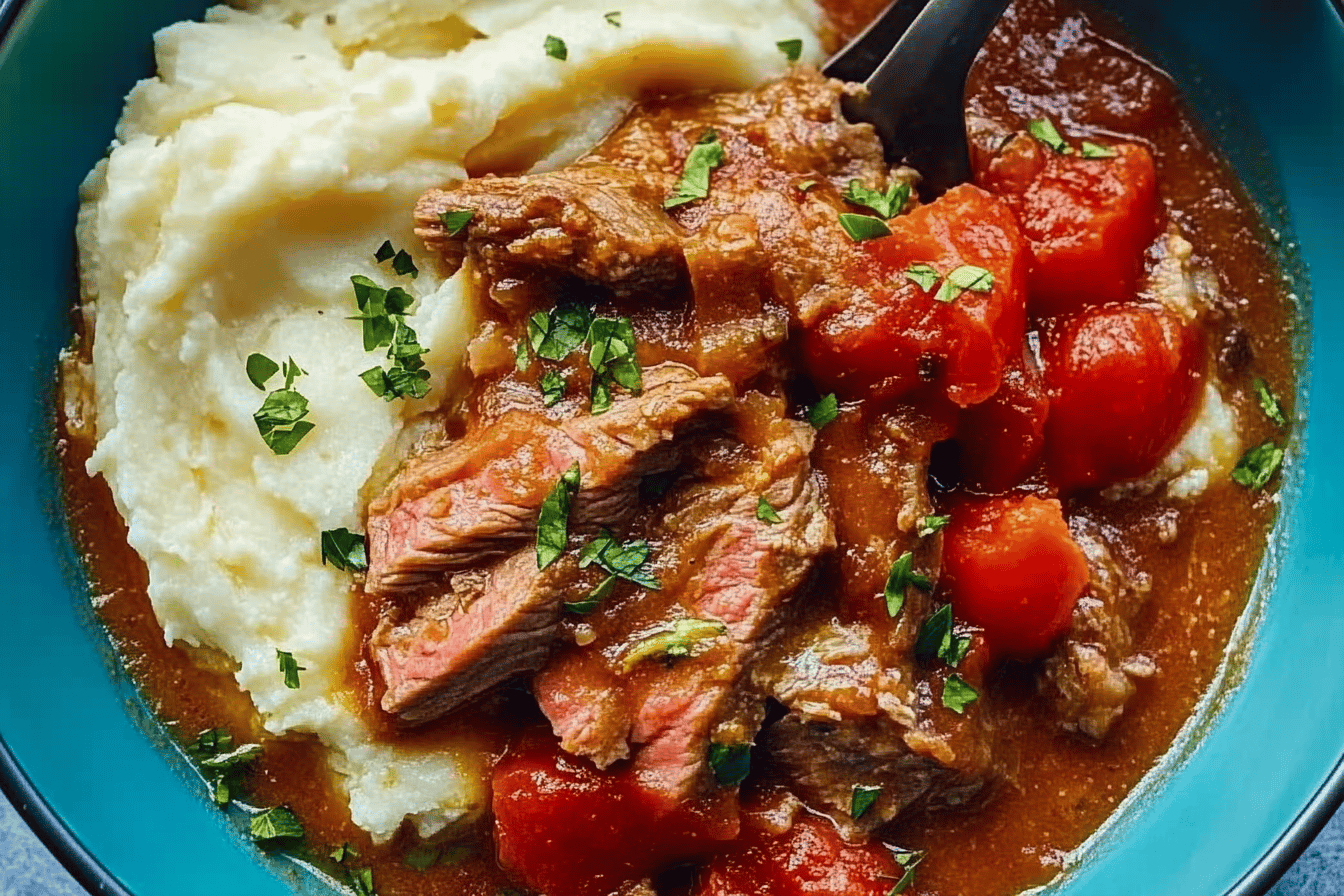Tender Swiss Steak is a beloved comfort food that brings warmth and satisfaction to any dinner table. This dish, with its roots in American cuisine, showcases the art of braising, a technique that transforms tougher cuts of beef into succulent, melt-in-your-mouth meals. Traditional Swiss steak is often characterized by its rich tomato-based sauce, which not only enhances the flavor of the beef but also creates a hearty dish that can be paired with various sides. Whether you’re preparing for a family gathering or a cozy night in, this recipe is perfect for those moments when you want to impress without spending the entire day in the kitchen. Its simplicity, combined with the depth of flavor, makes it a special dish for occasions ranging from casual weeknight dinners to festive celebrations.
Tools and Equipment
To create the perfect tender Swiss steak, you’ll need some essential kitchen tools that will make the cooking process smooth and enjoyable. Here’s a list of what you’ll need:
- Meat mallet: For tenderizing the steak.
- Cutting board: A sturdy surface for chopping vegetables.
- Knife: A sharp knife for slicing and dicing ingredients.
- Dutch oven: Ideal for browning the meat and simmering the sauce.
- Measuring cups and spoons: For accurate ingredient measurements.
- Spatula or wooden spoon: For stirring the sauce.
- Oven mitts: To handle the hot Dutch oven safely.
- Serving spoon: For ladling the finished dish onto plates.
Ingredients List
Gathering the right ingredients is crucial for the success of your Swiss steak. Here’s what you’ll need:
- 2 lbs. bottom round or top round steak, pounded 1/2 inch thick
- Kosher salt and fresh ground black pepper
- ½ cup all-purpose flour
- 2-3 tablespoons vegetable oil
- 1 onion, sliced half-moon
- 3 carrots, peeled and cut in 1-inch chunks
- 3 cloves garlic, minced
- 2 tablespoons tomato paste
- 2 cups low sodium beef broth
- 2 14.5 ounce cans diced tomatoes
- 1 tablespoon Worcestershire Sauce
- 1 teaspoon marjoram
- ½ teaspoon dried thyme
- ¼ teaspoon paprika
Each ingredient plays a vital role in building the dish’s flavor profile:
Beef: The star of the dish, bottom or top round steak is best for braising, as it becomes tender when cooked slowly.
Flour: Dredging the meat in flour before browning helps create a delicious crust and thickens the sauce.
Vegetable oil: Used for searing the meat, it helps achieve a nice browning without burning.
Onions and carrots: These aromatics add sweetness and depth to the sauce.
Garlic: A must for flavor, garlic enhances the overall taste of the dish.
Tomato paste and diced tomatoes: They create the rich tomato sauce that is comforting and flavorful.
Beef broth: Provides a savory base for the sauce.
Worcestershire sauce: This adds a tangy depth of flavor, enriching the sauce.
Herbs and spices: Marjoram, thyme, and paprika contribute to the aromatic and flavorful profile of the dish.
Preparation Steps
Before you start cooking, it’s important to prepare your ingredients properly. Follow these pre-cooking steps:
- Tenderize the steak: Use a meat mallet to pound the steak to about 1/2 inch thickness. This helps break down the fibers for a tender result.
- Season the meat: Generously season both sides of the steak with kosher salt and fresh ground black pepper.
- Dredge in flour: Place the flour in a shallow dish and coat the seasoned steak, shaking off any excess flour.
- Prepare vegetables: Slice the onion, chop the carrots, and mince the garlic to have everything ready for cooking.
Tip: Having all ingredients prepped and ready to go will streamline the cooking process and ensure nothing is overlooked.
Step-by-Step Cooking Instructions
Now that you’ve prepared your ingredients, it’s time for the fun part—cooking! Follow these steps for a delicious tender Swiss steak:
- Preheat your oven: Set your oven to 350 degrees F (175 degrees C) to prepare for baking the dish.
- Brown the steak: In a Dutch oven, heat 1 1/2 tablespoons of vegetable oil over medium-high heat. Add the floured steak and brown it on both sides, about 3-4 minutes per side. Remove the steak and set it aside on a plate.
- Cook the vegetables: In the same pot, add the remaining oil, sliced onions, and carrot chunks. Cook until the onions become tender, about 5-7 minutes.
- Add garlic: Reduce the heat to low and stir in the minced garlic. Cook for 1 minute, stirring constantly to prevent burning.
- Incorporate the sauce ingredients: Stir in the tomato paste, beef broth, diced tomatoes (with their juices), Worcestershire sauce, marjoram, thyme, and paprika. Mix well to combine.
- Return the beef: Place the browned steak back in the pot, ensuring it is submerged in the sauce. Scrape the bottom of the pot to loosen any browned bits for extra flavor.
- Cover and bake: Cover the Dutch oven and transfer it to the preheated oven. Bake for 2 hours, or until the meat is very tender.
Note: If you prefer, you can also cook this dish on the stovetop by simmering it covered for about 1 1/2 hours until the beef is tender.
Nutritional Information and Health Benefits
Tender Swiss steak is not only delicious but also provides a variety of nutritional benefits. This dish is rich in protein, which is essential for muscle repair and growth. The beef in this recipe offers important vitamins and minerals, including:
- Iron: Vital for transporting oxygen in the blood.
- Zinc: Supports immune function and wound healing.
- B vitamins: Important for energy production and brain health.
Additionally, the vegetables in this dish—such as carrots and onions—contribute dietary fiber, vitamins, and antioxidants that promote overall health. When served with sides like mashed potatoes or whole grains, this meal can be balanced and satisfying.
Common Mistakes and Tips to Perfect the Recipe
To ensure you achieve the best results with your tender Swiss steak, be mindful of these common mistakes:
- Not tenderizing the meat: Skipping this step can result in a tougher texture. Always pound the steak to break down the fibers.
- Overcrowding the pot: If your Dutch oven is too crowded while browning the meat, it won’t sear properly. Brown in batches if necessary.
- Not allowing enough cooking time: Be patient and allow the steak to simmer long enough for it to become tender.
- Skipping the scraping step: Don’t forget to scrape the bottom of the pot for those flavorful browned bits!
Advanced Tip: For an extra layer of flavor, you can add a splash of red wine to the sauce after browning the vegetables and before adding the tomato paste.
Storage, Serving, and Reheating Tips
Once your tender Swiss steak is cooked, consider these storage and serving suggestions:
- Serving options: This dish pairs beautifully with mashed potatoes, egg noodles, or white rice. You can also serve it with crusty bread to soak up the delicious sauce.
- Storage: Store any leftovers in an airtight container in the refrigerator for up to 3 days.
- Freezing: To freeze, use a sturdy freezer container and store for up to 3 months. Thaw in the refrigerator overnight before reheating.
When reheating, do so gently on the stovetop or in the microwave until heated through. Adding a splash of beef broth can help restore moisture if needed.
FAQs and Recipe Variations
What cut of beef is best for Swiss steak?
Bottom round or top round steak is ideal due to its balance of flavor and tenderness when braised. You can also use chuck roast if you prefer.
Can I make this dish in a slow cooker?
Yes! After browning the meat and sautéing the vegetables, transfer everything to a slow cooker and cook on low for 6-8 hours for a delicious, hands-off version.
What are some variations of this recipe?
- Add bell peppers for extra sweetness and color.
- Incorporate mushrooms for an earthy flavor.
- For a spicy kick, add red pepper flakes or diced jalapeños.
- Use different herbs like rosemary or basil for unique flavor profiles.
Conclusion
Tender Swiss steak is more than just a meal; it’s an experience that brings family and friends together around the dinner table. With its rich flavors and comforting aroma, this dish is sure to become a favorite in your household. The ease of preparation, combined with the satisfaction of a hearty, home-cooked meal, makes it a must-try recipe. So gather your ingredients, don your apron, and enjoy the simple pleasure of creating a dish that warms both the heart and the palate.
Don’t hesitate to try this recipe and share the love of cooking with those around you!

